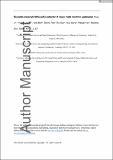Notice
This is not the latest version of this item. The latest version can be found at:https://dspace.mit.edu/handle/1721.1/140306.2
Reusable Polyacrylonitrile‐Sulfur Extractor of Heavy Metal Ions from Wastewater
| dc.contributor.author | Li, Peng | |
| dc.contributor.author | Jiang, Haibin | |
| dc.contributor.author | Barr, Ariel | |
| dc.contributor.author | Ren, Zhichu | |
| dc.contributor.author | Gao, Rui | |
| dc.contributor.author | Wang, Hua | |
| dc.contributor.author | Fan, Weiwei | |
| dc.contributor.author | Zhu, Meifang | |
| dc.contributor.author | Xu, Guiyin | |
| dc.contributor.author | Li, Ju | |
| dc.date.accessioned | 2022-02-14T13:48:07Z | |
| dc.date.available | 2022-02-14T13:48:07Z | |
| dc.date.issued | 2021-08-27 | |
| dc.identifier.issn | 1616-301X | |
| dc.identifier.issn | 1616-3028 | |
| dc.identifier.uri | https://hdl.handle.net/1721.1/140306 | |
| dc.description.abstract | Mercury, lead, and cadmium are among the most toxic and carcinogenic heavy metal ions (HMIs), posing serious threats to the sustainability of aquatic ecosystems and public health. There is an urgent need to remove these ions from water by a cheap but green process. Traditional methods have insufficient removal efficiency and reusability. Structurally robust, large surface-area adsorbents functionalized with high-selectivity affinity to HMIs are attractive filter materials. Here, an adsorbent prepared by vulcanization of polyacrylonitrile (PAN), a nitrogen-rich polymer, is reported, giving rise to PAN-S nanoparticles with cyclic π-conjugated backbone and electronic conductivity. PAN-S can be coated on ultra-robust melamine (ML) foam by simple dipping and drying. In agreement with hard/soft acid/base theory, N- and S-containing soft Lewis bases have strong binding to Hg2+, Pb2+, Cu2+, and Cd2+, with extraordinary capture efficiency and performance stability. Furthermore, the used filters, when collected and electrochemically biased in a recycling bath, can release the HMIs into the bath and electrodeposit on the counter-electrode as metallic Hg0, Pb0, Cu0, and Cd0, and the PAN-S@ML filter can then be reused at least 6 times as new. The electronically conductive PAN-S@ML filter can be fabricated cheaply and holds promise for scale-up applications. | en_US |
| dc.language | en | |
| dc.publisher | Wiley | en_US |
| dc.relation.isversionof | http://dx.doi.org/10.1002/adfm.202105845 | en_US |
| dc.rights | Creative Commons Attribution-Noncommercial-Share Alike | en_US |
| dc.rights.uri | http://creativecommons.org/licenses/by-nc-sa/4.0/ | en_US |
| dc.source | Wiley | en_US |
| dc.title | Reusable Polyacrylonitrile‐Sulfur Extractor of Heavy Metal Ions from Wastewater | en_US |
| dc.type | Article | en_US |
| dc.identifier.citation | Li, Peng, Jiang, Haibin, Barr, Ariel, Ren, Zhichu, Gao, Rui et al. 2021. "Reusable Polyacrylonitrile‐Sulfur Extractor of Heavy Metal Ions from Wastewater." Advanced Functional Materials, 31 (51). | |
| dc.relation.journal | Advanced Functional Materials | en_US |
| dc.eprint.version | Author's final manuscript | en_US |
| dc.type.uri | http://purl.org/eprint/type/JournalArticle | en_US |
| eprint.status | http://purl.org/eprint/status/PeerReviewed | en_US |
| dspace.date.submission | 2022-02-09T19:49:28Z | |
| mit.journal.volume | 31 | en_US |
| mit.journal.issue | 51 | en_US |
| mit.license | OPEN_ACCESS_POLICY | |
| mit.metadata.status | Authority Work and Publication Information Needed | en_US |
